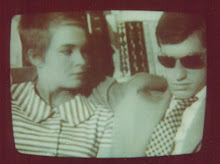I saw this film when it was first released, but found myself watching it again and immersing myself in a simpler time and place. The Martin Provost film shows the life of a simple peasant woman during the early 20th century--living alone with no family or friends in the countryside of Senlis, France.
Seraphine (Yolande Moreau) spends her days working as a simple cleaning woman. She leaves her daily job to wander and sit among trees and flowers. We learn that she is a deeply spiritual person who has spent time with nuns and was called by a spiritual force to paint. She knows nothing of the modern art world of Picasso and Braque that was exploding just miles away in Paris, but Seraphine spends the little money she has on wood and pigments from a local merchant. While journeying through the countryside, she collects cooking oils, melted candlewax, blood, flowers and mud to concoct her paints. Seraphine lives on food offerings from her employer, crumbs of bread and "energy wine" she brews while working. She returns to her tiny room to paint all evening by candlelight.
The film takes us on a vivid journey with her as the gentleman she cleans for turns out to be Wilhelm Uhde, a Paris art collector. He eventually discovers her secret life as a painter and her vibrant pictures of foliage and flowers. Uhde is moved by her exceptional talent, as he had recently discovered the Primitive Moderne style of the painter, Rousseau and his good friend, Kahnweiler, was introducing the paintings of Picasso.
Uhde's attention and encouragement sparked Seraphine to work ossessively--even as the war breaks out and many flee, including Uhde. All the people of means leave town, but she remains and continues to paint as bombs sound in the distance. Udhe returns several years later and resumes his support of her career by offering a monthly stipend. The big show he promises is delayed due to the sinking economy of the late 1920s and Seraphine's fragile mental state deteriorates.
The encounter with Uhde saved her work from obscurity and Seraphine de Senlis has often been grouped with the naive primitive painters referred to as Sacred Heart Painters. The best part of this story is not her discovery by a powerful collector. More fascinating--her ability to express human creative nature, despite lack of education, money, class.
1/15/11
Subscribe to:
Post Comments (Atom)






No comments:
Post a Comment